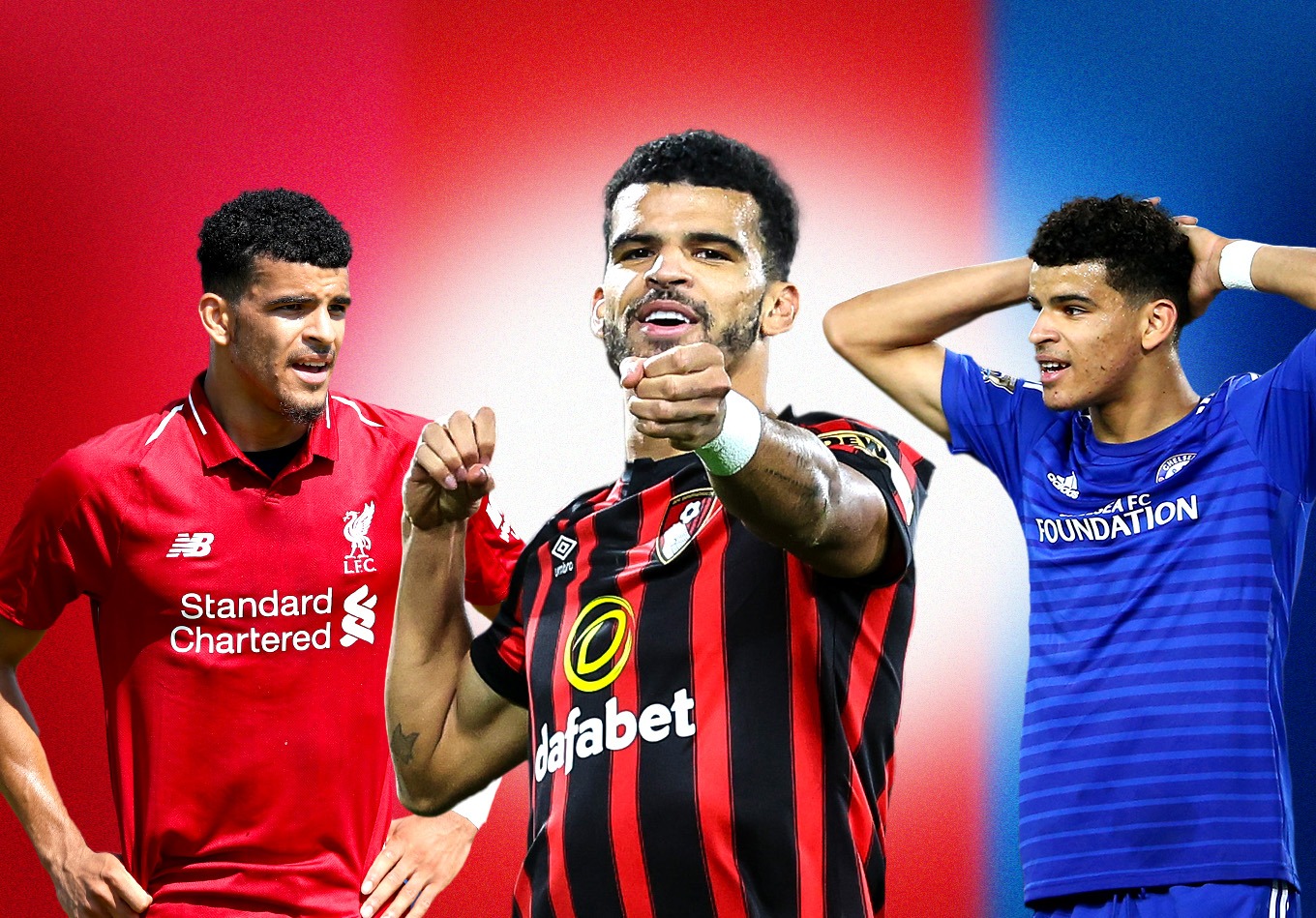For years, Dominic Solanke looked to be falling short of the potential he showed as a teenager, but the 2023-24 campaign has seen him take huge strides.
For Dominic Solanke, the road to fulfilling the promise he showed as a teenager has been a lengthy one. It’s easy to forget how long he’s been around at this level; after all, October 2024 will mark 10 years since his first-team bow at Chelsea, where he became the club’s youngest ever Champions League player a little over a month after his 17th birthday.
Considering his reputation in youth football at the time and the regard he was held in by Chelsea, many might’ve thought Solanke would go on to experience Champions League nights on a regular basis, but only another three appearances in the competition have followed over the subsequent nine and a bit years.
The 2023-24 campaign has been something of a coming-of-age story for Solanke, however. No more is he that once-hyped English striker who looks more at home in the Championship; no, now he’s one of the Premier League’s in-form strikers and an absolutely vital component in his team’s setup as he prepares to face Liverpool – another of his former clubs – this Sunday.
His transformation has been considerable, and swift. Questions were still being asked about him as recently as last season, with Solanke going 1,020 minutes (or 17 hours and 20 minutes) without a Premier League goal for Bournemouth between November 2022 and April 2023, but this term he’s enjoyed a decisiveness that we’ve simply never seen from him before at top-flight level.
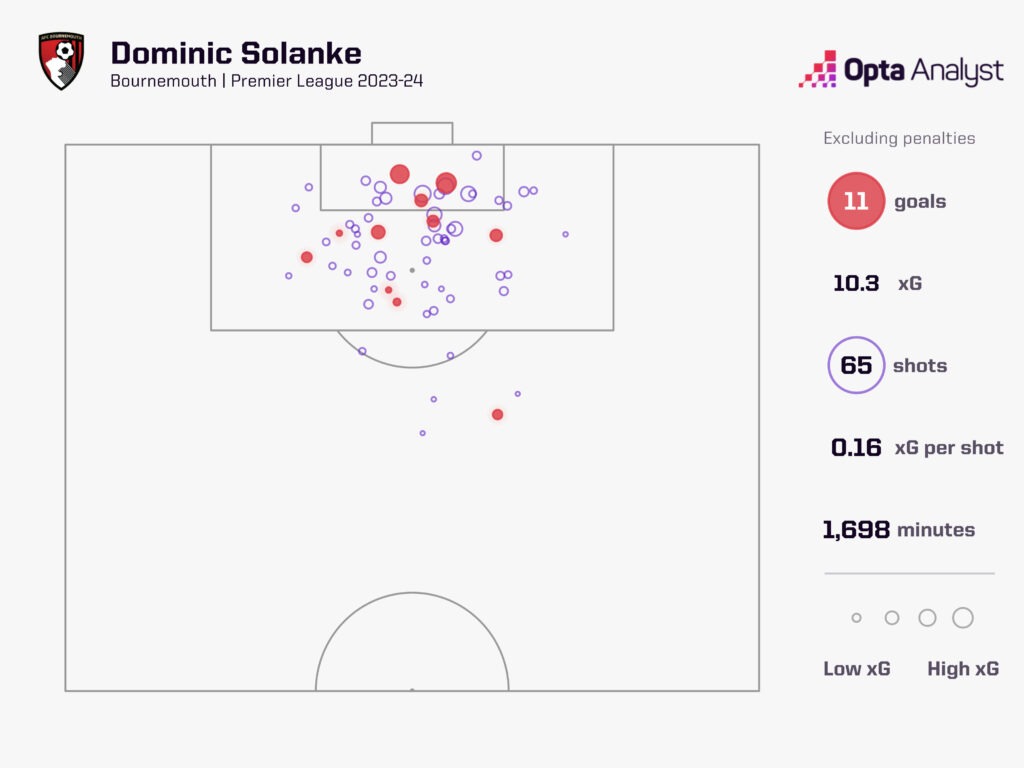
In 2023-24, Solanke is averaging 0.64 goals per 90 minutes in the Premier League, which is a huge uptick from his record at this level before this season. Over his 96 top-flight games prior to August 2023, he’d only scored 10 times, at a rate of 0.17 every 90 minutes; his total of 12 this term is already clear of that.
His numbers in front of goal have improved practically across the board. He’s now converting 18.2% of his shots, compared to 7.1% across those 96 prior Premier League games; his shot frequency is up to 3.5 per 90 from 2.3; and his big-chance conversion rate has more than doubled from 26.1% to 56.3%.
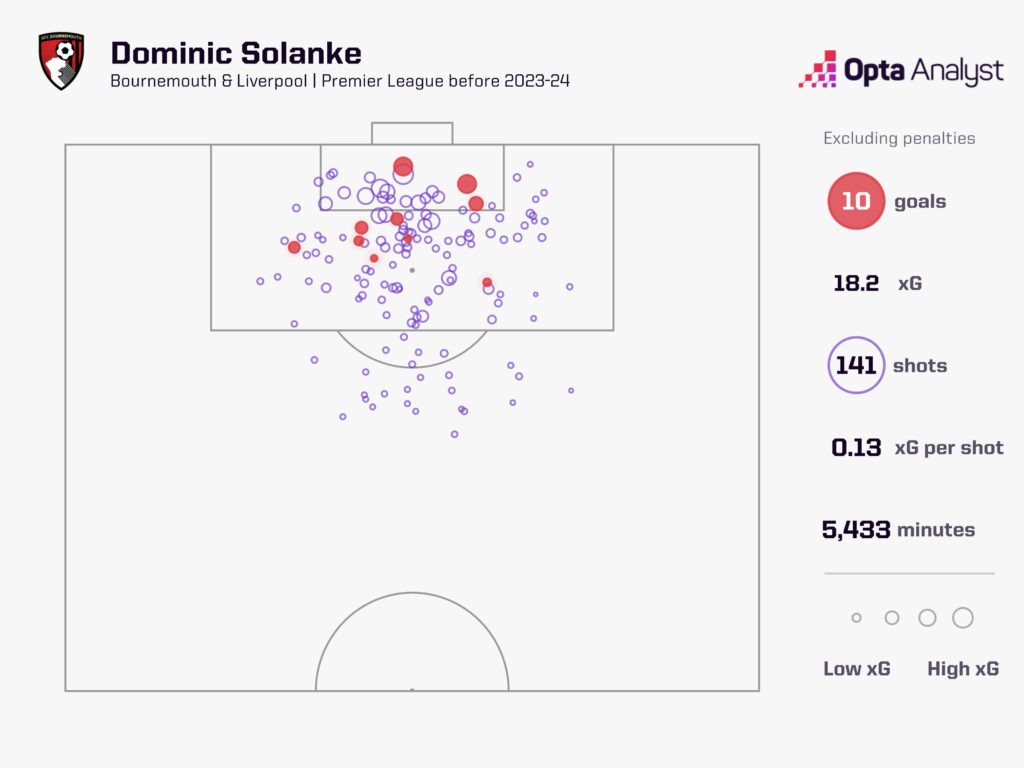
Of course, looking at his output over 96 games is slightly flawed as it gives as much weight to his relative formative years at Liverpool and early days at Bournemouth – when he went 30 hours and 8 minutes without a Premier League goal – as it does to last season, when Solanke was back in the Premier League after a couple of character-building years in the Championship.
Nevertheless, even from the 2022-23 campaign there has been a major change for the better in terms of productivity, with his increase of 1.1 from 2.4 shots per 90 minutes a good starting point for a striker; he’s getting more shots away than ever before in his top-flight career.
But most importantly, Solanke is combining that improved shot frequency with receiving the ball in better positions now. That can probably be at least partly attributed to his teammates providing more reliable service, but there’s little question he’s matured as a centre-forward and confidence is flowing through him.
Among those to have played at least 500 minutes in the Premier League this term, only eight have a better non-penalty expected goals (xG) per 90 record than his 0.54, which highlights how he’s getting shots away in threatening positions. His best non-penalty xG average over a single Premier League season for Bournemouth had been 0.29 last term; he’s way up on that, though Solanke’s also proving far more dependable with the chances that fall to him, scoring 0.58 non-penalty goals every 90 minutes in 2023-24 after never going above 0.19 for a full Premier League season beforehand.
But to focus just on what Solanke is now offering in front of goal would be to do him – and Bournemouth – a disservice. Sure, as a centre-forward, being able to score frequently is obviously an important skill to have, especially given his record in this regard had previously been poor in the top flight. However, it’s what he offers off the ball that helps ensure Solanke is influential beyond the opposition’s penalty box – and he feels this has actually positively impacted the positions he’s getting into.
A fine physical specimen, Solanke has that blend of athleticism and game intelligence that can make such a difference in the Premier League, particularly in a team like Iraola’s Bournemouth.
“Part of my success is because the manager loves pressing high,” Solanke told The Times in an interview last month. “I’m high up the pitch, in the centre of the goal much of the time, and not having to drop back too much and am finding myself in good positions, more than last season probably. The manager’s style definitely suits me.”
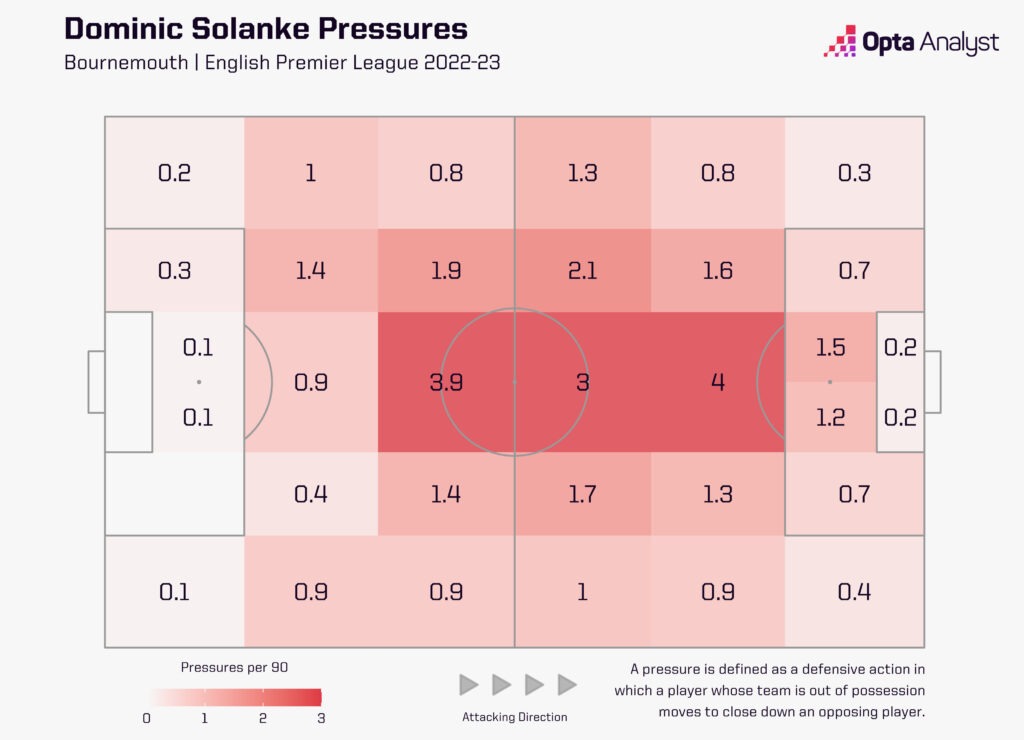
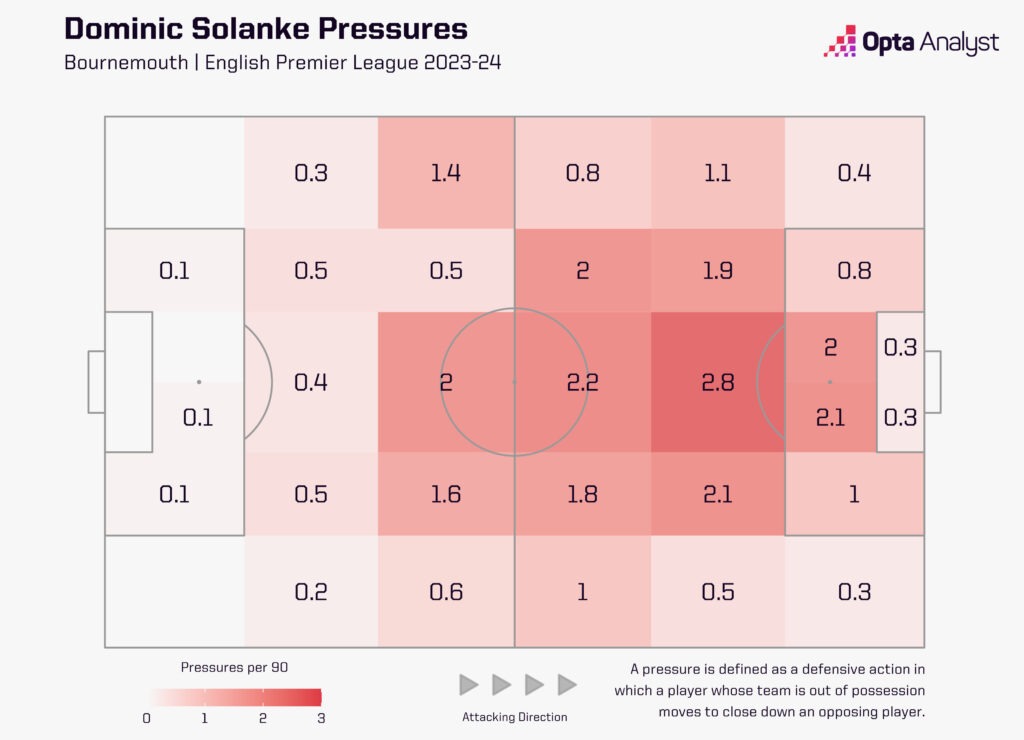
Iraola’s Rayo Vallecano side were renowned for their distinct style of play, which centred on an aggressive approach to applying pressure and winning the ball back as high up the pitch as possible. They recorded 68 high turnovers that led to a shot in La Liga last season, which was second only to Bayern Munich (73) among all clubs in the top five leagues; it was a cornerstone of their system and its successful implementation was a major reason the former Athletic Bilbao player was so sought-after prior to making the move to Bournemouth.
“We couldn’t take in all the information at first,” Solanke added in the same interview. “For me, I’m pressing with a No. 10 behind me and, at first, our timing was off. We didn’t know when to press or to drop, but now it’s second nature as the manager has gone through it many times and it’s embedded in our heads and we are all on the same wavelength. It’s natural now.”
Evidently.
No Premier League player has recorded more pressures in the final third than Solanke this season (288) and he also ranks as high as 13th for pressures in the middle third (260). His work rate has been a real asset to Bournemouth as they look to profit from their on-field proactivity.
When analysing the Cherries’ pressing habits, it might be tempting to zone in on their 166 high turnovers putting them only mid-table in the rankings for that metric, but a lot of their hard work off the ball happens in the middle third. For instance, their 14.7 pressed sequences per game is bettered by only three teams in the Premier League, while it’s also worth highlighting their efficiency with high turnovers; 3.6% of their 166 have led to a goal (six), the joint-best record in the division.
Working hard in this manner isn’t new to Bournemouth or Solanke. Last season, he tallied more pressures (1,134) than any other player in the Premier League, but one manager’s pressing plan isn’t the same as the next manager’s; the targets, triggers and even the desired outcome could be entirely different, and clearly there’s been a change with Solanke.
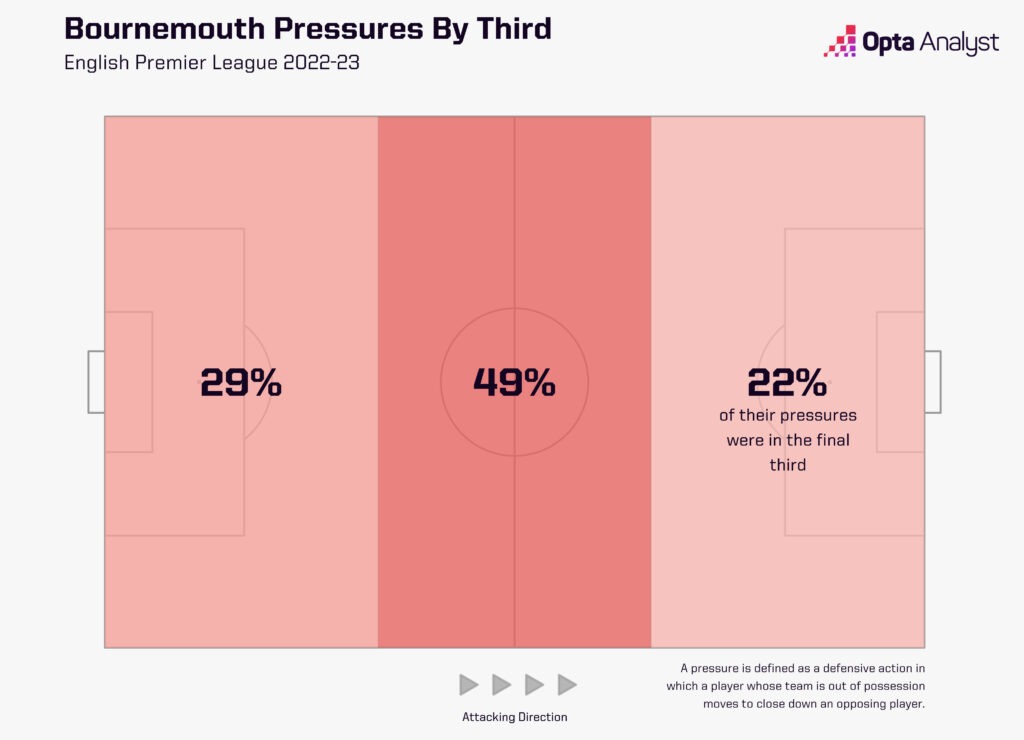
In 2022-23, only 35.8% of his pressures were confined to the final third; 13.8% of them occurred in Bournemouth’s own defensive third, meaning a little over half (50.4%) were recorded in the middle third. This season, however, Solanke’s pressing has been far more localised to the final third (49.1%), where the biggest proportion of his pressures have taken place, with just 6.6% occurring in Bournemouth’s defensive third and 44.3% in the middle.
It’s easy to see why then that Solanke feels Iraola’s approach to pressing has been fundamental in his own broader improvement. He’s still doing much of the same work as before, just higher up the pitch, providing him with more responsibility – and action – in the areas a striker wants to be in.
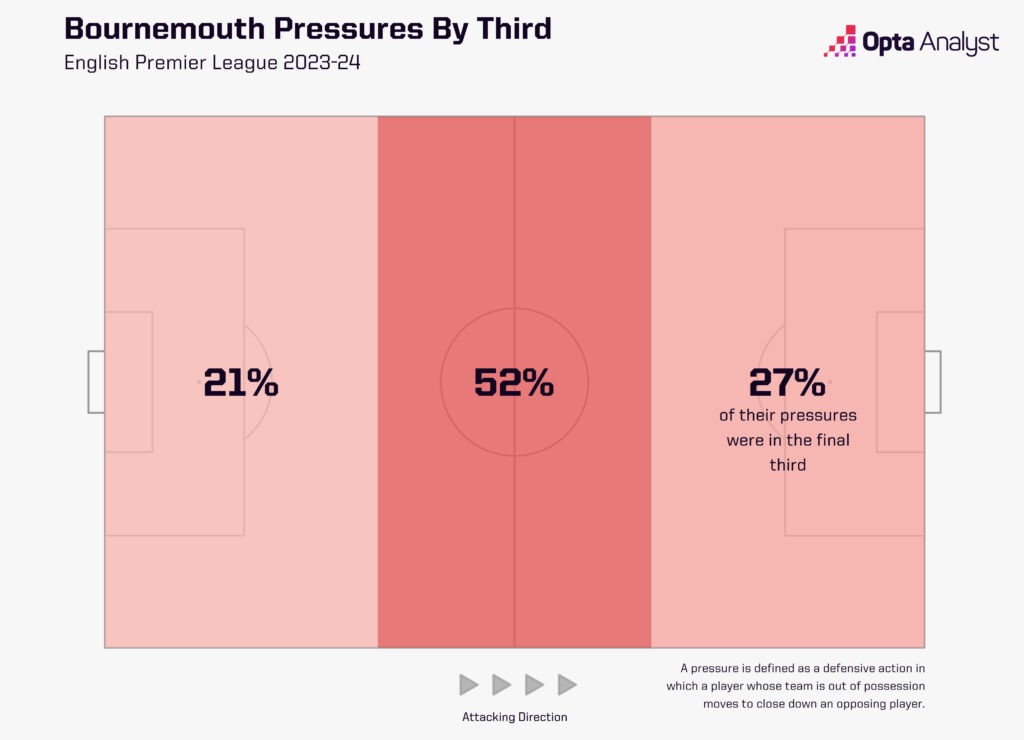
As such, the proportion of Solanke’s shots taking place in the penalty area are up from 86.6% last term to 90.9% this season, while his touches in the opposition’s box are up to 6.8 per 90 from 5.6.
This all feeds back into his overall improvement in front of goal, which is arguably best summed up by the fact his goals account for 42.9% of Bournemouth’s Premier League total this term; only five players in the top five European leagues have scored a greater proportion of their team’s goals than Solanke in 2023-24.
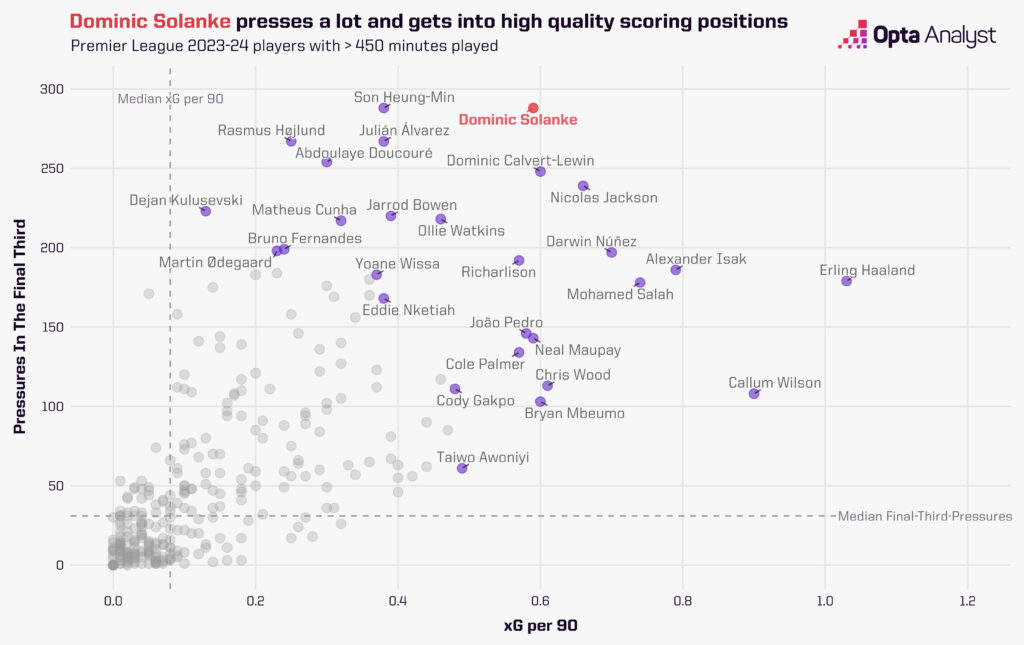
So, is it any wonder that teams like Arsenal and Newcastle – sides who are renowned for their work rate off the ball – have been so strongly linked with Solanke?
Sure, there’ll be some tempering their excitement for a little while longer, waiting to see how long he sustains this form because, as we’ve highlighted, the improvement is dramatic in many respects. Is this simply a flash in the pan or is Solanke finally maintaining the level many expected him to reach when he was younger?
Although that’s impossible to answer at the moment, the signs are clearly positive and Sunday’s visit of Liverpool is the perfect opportunity for him to make a few more people sit up and take note. Sometimes a player just needs the right manager and the right time; it feels like the stars have finally aligned for Solanke, with Iraola’s arrival potentially the making of him.
Enjoy this? Subscribe to our new football newsletter to receive exclusive weekly content. You should also follow our social accounts over on X, Instagram, TikTok and Facebook.
